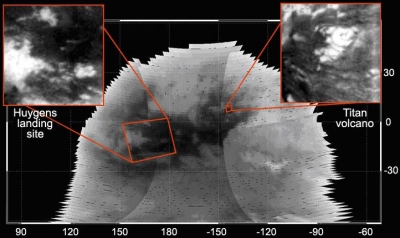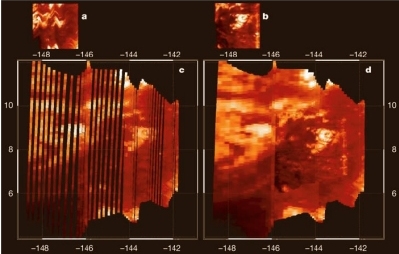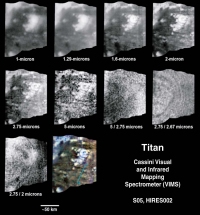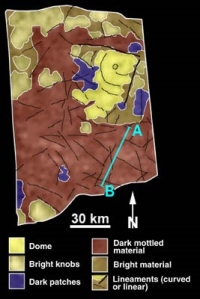Possible Cryovolcano on Titan
9 June 2005
Titan possesses a dense atmosphere with a surface pressure of 1.5 bar and with N2 as its main constituent. Methane is the second most important component, but it is photodissociated on a timescale of 107 years. Because methane is still observed in Titan's atmosphere a replenishment process must be taking place through either surface, or subsurface, hydrocarbons.Images acquired during the Cassini flyby of 26 October 2004 reveal that a widespread methane ocean does not exist. Variations in albedo measurement are almost certainly topographical differences due to a solid/icy surface.
Within the images obtained one feature of interest was identified: a circular structure around 30 km in diameter. Analysis by Sotin et al., and published in Nature, suggest this feature is probably a dome formed by upwelling plumes that release methane into Titan's atmosphere.
The observations were made using the VIMS instrument, which operates in the wavelength range 0.35 to 5.2 microns. At a range of 2.01 to 2.03 microns the instrument has the greatest signal to noise ratio, which is the bandwidth for these observations.
The first figure below shows a number of features including the Huygens landing site and the circular surface feature. The second figure shows high-resolution images of the region containing the feature. The images span a 25 minute period and since the feature does not move it is possible to eliminate it as an atmospheric feature.
 |
|
Figure 1: The VIMS instrument took hyperspectral images from the visible to 5.2 µm wavelength. This figure shows the mosaic obtained at 2.03 µm; horizontal and vertical axes show respectively longitude and latitude in degrees. Observations are centred around the anti-Saturn point. Left inset, high-resolution (30 kmpixel-1) image, taken to provide the global setting of the site where the Huygens probe successfully landed on 14 January 2005. |
 |
|
Figure 2: Two high-resolution images were taken during a 25-min period that ended just before closest approach. Because the spacecraft was moving at 5.8 kms-1 (about 20 000kmh-1) relative to Titan, image motion compensation was required so as to point to the same location on Titan’s surface. Two images were acquired of the same area 20 min apart. |
The circular feature also has two elongated features extending westward across the moon's surface. These features are also observed surrounding volcanoes on Earth and Venus.
 |
|
Figure 3: Details of the circular feature show up at wavelengths larger than 1.3 µm. |
 |
|
Figure 4: A geological interpretation of the region based on albedo and texture variations |
- The bright regions are about twice as bright as the dark regions
- The spectra of both regions are sufficiently similar to suggest similar composition
- Observations at around 2.75 microns indicate that little pure water ice is exposed.
- Images at 2 microns, 2.75 microns and 5 microns show east-west features that are not seen in the 5/2.7 micron ratio image, or 2.75/2 micron ratio image. These features roughly 20-50 km in length and 5-10 km in separation could be valleys and ridges (see Figure 4).
Variations in colour and albedo make it difficult to analyse the central part of the circular feature. At the central pixel at heart of the circular feature is dark in all infrared widows and suggests a real feature. The illumination is from the southwest suggesting that the pixel is in shadow as it lies in a depression possibly in the form of a caldera.
The east-west linear features could be tectonic in origin. Similar features are found on Jupiter's moon Ganymede where they are thought to be casued in a resurfacing process associated with upwelling.
It is possible that a similar process is at work on Titan. Tidal heating, heating due to the gravitational forces created by Titan's eccentric orbit, could create localised subsurface hot spots, which can in turn cause surface changes. It should be noted that hot spot here is a relative term and the temperatures involved are still of the order 100 K.

